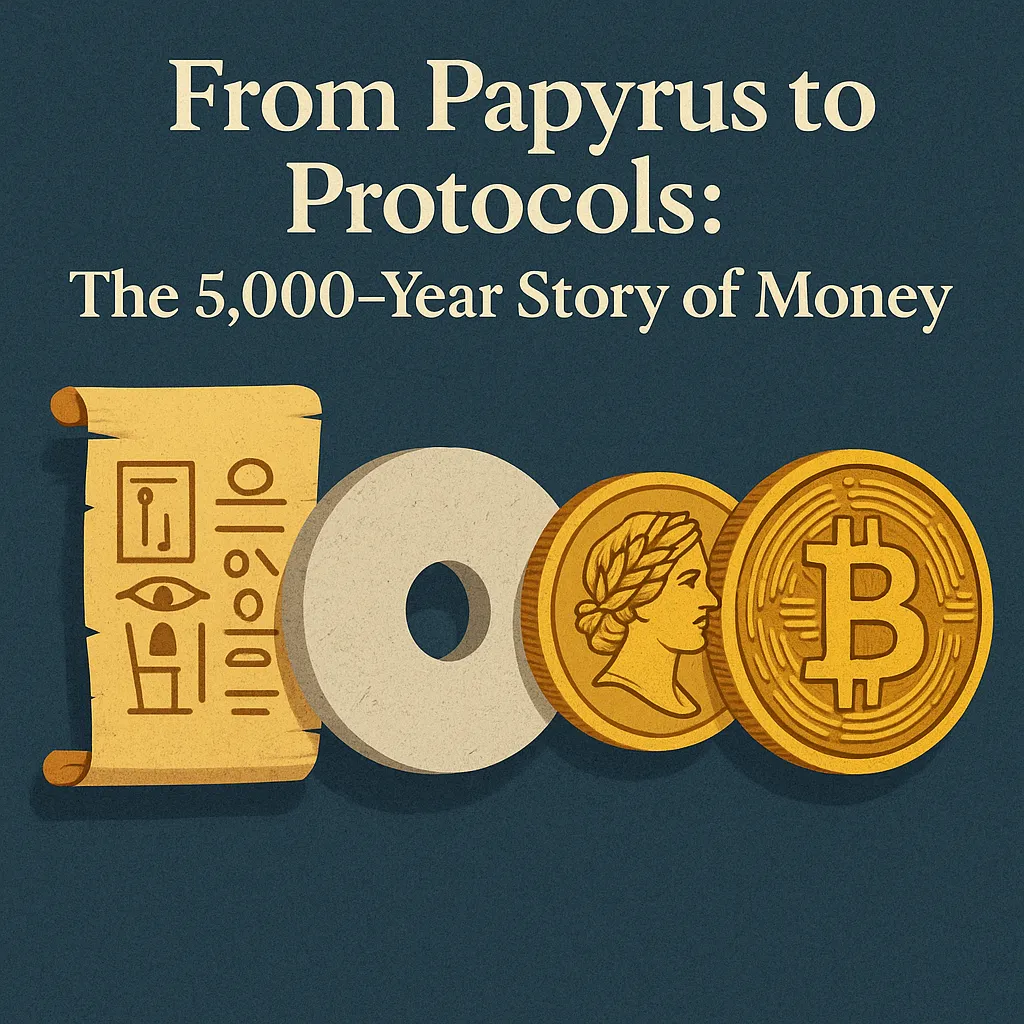
From Papyrus to Protocols: The 5,000-Year Story of Money
Money is humanity’s oldest shared technology. Long before we built cities, railroads, or the internet, we built systems to exchange value. From carved stones to paper bills to digital ledgers, money has always been more than a tool — it has been the foundation of civilization itself.
But the story of money is not just about objects or tokens. It’s about trust. Each form of money represents a solution to the same problem: how do strangers trade, save, and cooperate without betraying one another?
To understand Bitcoin today, we must first trace the long arc of money’s history — from papyrus to protocols, from kings to computers, from promises to proof.
The First Ledgers: Tallies and Clay
The earliest money wasn’t coins or paper. It was information carved into objects. Archeologists have found tally sticks and notched bones from as far back as 30,000 years ago. These weren’t decorations. They were records.
In ancient Mesopotamia (modern-day Iraq), clay tablets served as ledgers. Farmers would mark how many goats they owed a neighbor or how much barley was promised after harvest. These clay records became the basis for the first cities. Without them, large-scale cooperation would have been impossible.
Money began not as “stuff” but as shared memory. The clay tablet was a primitive blockchain, anchoring human trust in durable records.
Commodity Money: Shells, Beads, and Salt
As trade expanded beyond local villages, people needed portable money. That’s when commodity money emerged.
Cowrie shells, glass beads, and salt were among the earliest examples. These items were valuable not because kings declared them so, but because they were scarce, durable, and widely recognized. Salt, in particular, was so essential that the word “salary” comes from the Latin salarium — payment in salt.
Commodity money worked because it was grounded in reality. It took time and effort to acquire shells, beads, or salt. They couldn’t be conjured from nothing.
The Gold Standard of the Ancient World
Eventually, metals replaced shells and beads. Gold, silver, and copper became dominant because they combined durability, scarcity, and divisibility better than any other material.
Lydia, an ancient kingdom in modern Turkey, minted the first gold coins around 600 BC. These coins were stamped with a mark of authenticity, making them trusted for trade across vast distances. Rome later refined this system, minting coins that fueled an empire.
Gold became humanity’s most enduring money because it had the right properties: it was scarce, did not rust, and could be divided without losing value. For centuries, gold underpinned trade routes stretching from China to Europe.
Paper Promises: From Papyrus to Banknotes
As commerce grew, lugging sacks of metal became impractical. Enter paper money.
In China during the Tang Dynasty (7th century), merchants began using promissory notes written on papyrus. These were receipts for stored coins, easier to carry than the coins themselves. By the 11th century, the Song Dynasty issued the first government-backed paper money.
Paper money spread westward through trade and conquest, eventually reaching Europe. By the 17th century, banks like the Bank of England were issuing notes redeemable for gold.
At first, these notes were trusted only because they could be exchanged for precious metals. But slowly, people began to trust the paper itself.
Fiat Money: The State’s Monopoly
Over time, governments realized they could issue paper without fully backing it in gold. Wars, deficits, and political ambitions encouraged rulers to print more than they had in reserves.
The U.S. dollar, once tied to gold, officially cut its last link in 1971 under President Richard Nixon. From then on, the dollar became fiat money — money backed not by gold, but by government decree.
Fiat currency is essentially trust outsourced to politicians and central bankers. The supply can be expanded at will, often justified as “stimulus” or “monetary policy.” But history shows that fiat money eventually suffers the same fate: debasement. From Rome’s silver coins to Weimar Germany’s marks to Venezuela’s bolívars, all government-controlled money trends toward inflation.
The bucket always leaks.
Digital Money: Bits Instead of Bills
In the late 20th century, money went digital. Credit cards, online banking, and payment apps transformed money from paper slips to numbers on screens.
But the system didn’t fundamentally change. Banks remained the gatekeepers, governments remained the issuers, and inflation remained the tax. Digital money was faster, but it was still fiat.
One problem persisted: how to create digital money that isn’t controlled by any one authority? How do you replicate the scarcity of gold in cyberspace?
Bitcoin: Money as Protocol
That problem was solved in 2009 with Bitcoin. For the first time in history, money became a protocol.
Bitcoin combined three breakthroughs:
Digital scarcity: Only 21 million will ever exist. The supply cannot be inflated.
Decentralization: No bank, company, or government controls it. Anyone can join the network.
Proof of Work: New coins are forged by expending real-world energy, ensuring creation cannot be faked.
Bitcoin is not just “digital gold.” It is a living, global ledger secured by mathematics and energy. Unlike fiat, it doesn’t rely on promises. Unlike gold, it doesn’t need guards or vaults. It is self-verifying, portable across borders, and incorruptible.
Why Protocols Matter
Money has always been about trust. From tally sticks to coins to banknotes, people had to trust someone — a neighbor, a king, or a bank. Bitcoin changes the equation.
Now, we don’t need to trust people. We trust math, code, and open consensus. Trust is distributed, not centralized. The protocol is the guarantor.
This is why Bitcoin is revolutionary. It isn’t protest money or just another investment. It is the final evolution of money — the transition from promises to proof.
The Arc of 5,000 Years
Clay tablets turned barter into records.
Shells and salt turned local trade into portable value.
Gold and silver turned empires into stable economies.
Paper notes turned value into promises.
Fiat currency turned promises into political power.
Bitcoin turned political power into protocol.
For 5,000 years, money has been a story of increasing abstraction: from physical goods to symbols to pure information. Bitcoin is the culmination of that arc — money as a neutral, digital protocol.
Why This Matters for You
Most people don’t think about the history of money when they swipe a card or deposit a paycheck. But that history shapes every opportunity and challenge in your financial life.
Inflation? That’s fiat’s legacy.
Wealth inequality? That’s the consequence of who controls issuance.
Financial exclusion? That’s gatekeeping by banks.
Bitcoin is not just a new technology. It is humanity’s answer to a 5,000-year-old question: how do we create money that everyone can trust, without relying on kings or bankers?
The answer is here. It is open, borderless, and unstoppable.
Conclusion: The Next 5,000 Years
Civilization rose on the back of money. The tools we used — from shells to coins to notes — shaped the way we built societies. But every form before Bitcoin relied on trust in people and institutions.
Bitcoin relies only on proof. It is the first form of money designed to last not just decades, but centuries. It is the blacksmith’s blade and the ocean current combined: forged in energy, flowing without permission.
From papyrus to protocols, the story of money has been a story of progress. Bitcoin is not the end of that story — it is the foundation for the next 5,000 years.
Shout out to BullishBTC.com – your guide from the old story of money to the new.



